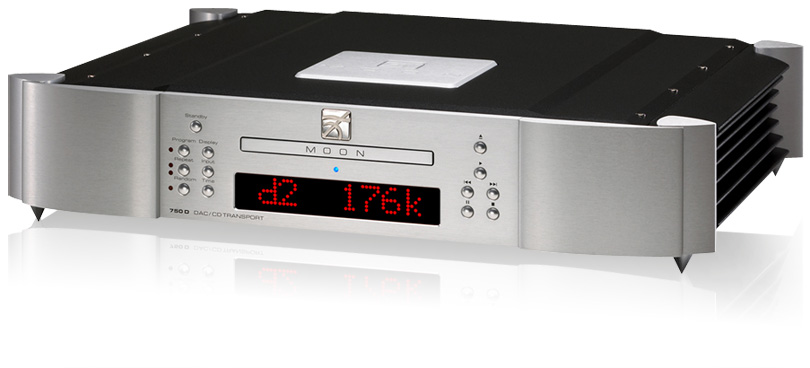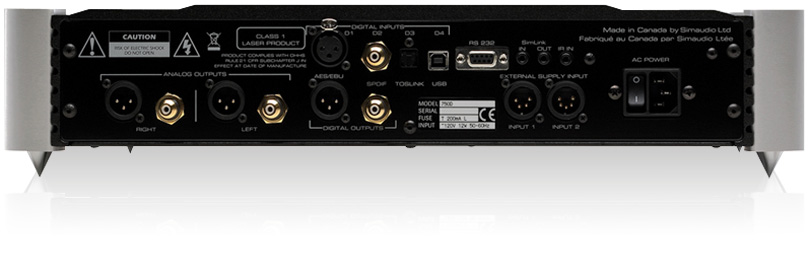| June 1, 2010


|
TWBAS
6/2010
Speakers:
Rockport Technologies Arrakis, Dynaudio Focus 360,
EgglestonWorks Andra III
Amplifiers:
Boulder Amplifiers 2060, Classé Audio Omega Omicron
Monos
Preamplifiers:
Simaudio Moon Evolution P-8, Boulder Amplifiers 1010
Sources:
Apple MacBook running iTunes and Amarra, Bel Canto
DAC3VB/VBS1
Cables and power conditioning:
All Shunyata Research: Aurora-IC interconnects,
Aurora-SP speaker cables, Hydra V-Ray II power
conditioner; Anaconda Helix Alpha/VX, Python Helix
Alpha/VX, Taipan Helix Alpha/VX power cords
|
|
|
Simaudio Moon Evolution 750D Digital-to-Analog Converter-CD
Transport
There was a time, in the not-too-distant past, when any mention of
solid-state electronics that were top-shelf in terms of price,
performance, and reputation had to include the likes of Krell and
Mark Levinson. It’s arguable just when the high-water mark for those
companies occurred, but I think many would say that, in Levinson’s
case, the No.33 and No.33H amplifiers and the No.30.6 D/A converter,
all of the late 1990s, mark the spot. Krell’s FPB-series products
were likely their best amplifiers ever; just a few years later, the
company’s foray into loudspeakers seemed to derail the once-great
brand.
Some will argue with me, but I don’t think anyone will say that
Krell is the company it was 15 years ago, especially considering
that founder Dan D’Agostino is no longer at the top of the
organizational chart. And the last Mark Levinson component we got in
for review had to be sent back because it appeared broken --
twice.
Things do change in high-end audio.
When you think of the great solid-state electronic products made
today in North America, the names that come up aren’t new -- the
likes of Classé, Boulder Amplifiers, Ayre Acoustics, and Simaudio
have solidified their positions in markets where others have
faltered or pulled back. Sure, plenty of new names have cropped up
as well, but many are in the price category of Are You Nuts?! Would
you pay 60 large for a preamp, or almost 80 grand for an amp,
from a company with no track record of customer support,
particularly when the companies I’ve just listed offer great
products at lower prices? Some reviewers might suggest that you
should,
but to me, that’s crazy. When reviewers fail to recognize the
relevance of such real-world considerations as value and reputation
when tens of thousands of dollars are being dropped, they’ve
dropped the ball.
Simaudio is an interesting case. I’ve met and talked with the
company’s president, Jean Poulin, and he’s no bean counter -- an
audiophile himself, Poulin is serious about his audio designs, and
creates products that he can feel passionate about. And in recent
years his company has been on a roll. Back in 2006, I called the
combination of three of Simaudio’s Moon Evolution models -- the
Andromeda CD player, P-8 preamplifier, and W-8 stereo amplifier -- a
contender for “my desert-island electronics.”
So when Jean Poulin introduced Simaudio’s Moon Evolution 750D
digital-to-analog converter and CD transport ($11,999 USD), I was
quick to request one for review.
The Moon Evolution 750D
It wouldn’t surprise me if the latest DAC chips were to get a
profile on Entertainment Tonight. There are in chips
and then there’s yesterday’s news, and the haute couture of DACs
these days is the ESS Sabre 32-bit chipset (ES9018S). If, for
Russian oil tycoons, someone decides to make an Apple iPhone
encrusted with DACs instead of diamonds, the ESS Sabre is what
they’ll use. There are 16 DACs in each ES9018S chip. According to Simaudio,
“For each channel, the outputs of four DACs are summed to create the
positive signal and the outputs of the other four DACs are summed to
create the inverted signal. Since a DAC’s output is in current, the
output of four DACs can easily be summed together to yield much
better results when compared to using one DAC per channel. The
reason for this is because there are unique imperfections for each
individual DAC. However, they become diluted within the current of
the other DACs. As well, there are imperfections common to all the
DACs in a circuit. These common imperfections are cancelled out
because of the differential topology used in the M-AJiC32 circuit.”
The M-AJiC32 -- the name is an abbreviation of Moon Asynchronous
Jitter Control in 32-bit mode -- is a jitter-reduction circuit said
to produce levels of jitter of just one measly picosecond.
The 750D has four digital inputs: AES/EBU, S/PDIF, TosLink, and USB,
all but the last able to accept digital signals of up to
24-bit/192kHz. (The USB input is limited to
16/48.) There are also
two digital outputs, AES/EBU and S/PDIF. And did I say that the 750D
includes a CD transport? Wouldn’t that make it a CD player?
Technically, yes -- but if you’ve been paying attention the past two
or three years, you’ve no doubt figured out that CD is in decline as
a recording format, and computer-based servers have become all the
rage. Knowing this, Simaudio has designed the 750D to serve, first
and foremost, the latter market. Nevertheless, Sim says, the 750D
contains a “Proprietary CD drive system mounted on our M-Quattro
gel-based four-point floating suspension for vibration damping,
allowing ambient and spatial cues in your recordings to come to life
like never before -- the fifth digital input.” The fifth
digital input? Make no mistake: the 750D is a DAC first. The
transport is a front-loading drawer with control buttons on each
side of the tray, the DAC’s Standby button and Input selector on the
left. My only gripe: At $11,999, the 750D should have a metal
drawer.
The 750D has other impressive features: fully balanced, differential
circuits; two separate toroidal transformers in the power supply;
four-layer PCBs; and a host of additional technologies and features
that Simaudio describes in detail on their website. The 750D is
built to the same standard as all other Moon Evolution components
I’ve seen, which is to say, very good: it’s a solid, brick-like
chassis of aluminum, with an engraved Moon logo adorning the top
panel. It measures 18.75”W x 4.0”H x 16.81”D and has a shipping
weight of 35 pounds. The sturdy chassis is flawlessly finished, and
the red dot-matrix display has numerals large enough to read from
across the room. I especially liked that the 750D displays the
sampling frequency, for those who’ll feed it multiple resolutions
and want verification of what they’re converting. It comes with the
same chunky FRM-2 aluminum remote control that accompanies other
Moon Evolution models, and which I mainly used to select the input.
Last, the 750D has two sets of outputs, RCA and XLR, as well as a
bidirectional RS-232 port. I used only the balanced outputs for my
listening, and extensively used the TosLink, USB, and S/PDIF inputs.

Sound
The Moon Evolution 750D is somewhat of a departure for Simaudio --
or, at the very least, an evolution (so to speak) in design that has
resulted in a sonic personality that is closer to neutral than the
“house sound” produced by Simaudio Evolution models past. When I
reviewed that Moon Evolution trio in 2006, I concluded that together
they produced an absolutely huge soundstage and sound tinted with a
warmish tone -- the overriding characteristics that I felt most
listeners would hear through their own systems. In the years since,
I’ve heard from many owners of Moon Evolution components, and every
one of them has heard what I heard.
The 750D was a slightly different animal. Sim’s warmish “house” tone
was muted, replaced by strikingly clear neutrality. But comparing
neutral to warmish primarily describes a component’s
tonal character. After several months of listening, I have no doubt
that the 750D was immensely neutral. Luckily for perspective owners,
that neutrality was also coupled with far greater transparency and
even better resolution of fine detail than I remember hearing from
the Moon Evolution Andromeda CD player ($14,999). The upshot is that
the 750D dug deeper into recordings to excavate even more
information from the original recorded event. It also removed that
slight shading of tonal warmth that, while nice, wasn’t entirely
true to the source.
I decided to write this “Sound” section a bit differently from those
of past reviews, in hopes of putting my findings in a context that
will be more useful not only to those contemplating a 750D as their
first Simaudio purchase, but also to owners of Sim gear looking to
upgrade within the line. I dug out the same recordings I’d used in
my 2006 Simaudio review and listened to them again, comparing my
findings with what I’d said about their sound through the Moon
Evolution Andromeda CD player way back when. I know that there are
flaws in this approach; to name one, my system has changed and
improved in the four years since. Nonetheless, being confident that
the personality of the Andromeda has shone through many different
systems, I think it’s fair to say that the same will hold true for
the 750D, such were its obvious strengths.
Back in 2006, I stated, “There was a glowing warmth to male vocals,
such as those on ‘Home,’ from Michael Bublé’s It’s Time
(Reprise 48946); and instrumental tracks such as ‘Max-O-Man,’ from
The Best of Fourplay (Warner Bros. 46661-2). The warmth I
heard didn’t sound like coloration per se, but an organic richness
that fully illuminated whatever music was on the discs I was
playing.” Through the 750D the warmth on these tracks wasn’t as
tangible, and certainly couldn’t be characterized as an overlay
veiling the recording, but the tonality of Bublé’s voice was still
warm because, well, that’s how he sounds. However, he didn’t sound
overly, obviously warm. The 750D’s sound had no digital edge to it
-- it was clear as a bell without sounding hyper-clear. There
were no spotlit frequencies, nothing that hindered voices from
sounding natural and palpable. The Fourplay track had a snappy sound
that got the pacing of the song just a touch more correct than what
I remember hearing from the older Sims. I could hear details such as
finger snaps in these two recordings even better, and this retrieval
of detail always served the music. Sometimes, when electronics sound
thin or lightweight, you get the sense of greater air and detail,
but that wasn’t the case with the 750D -- its sound was jam-packed
with information, but it still maintained a healthy dose of
microlevel detail.
In the following sentence from my 2006 review, I homed in on the
word smooth: “That warmish tone didn’t overlay the music in a
negative way; there was no veiling of Bruce Cockburn’s raspy voice
or smooth guitar on ‘Mango,’ from Breakfast in
New Orleans, Dinner in
Timbuktu
(Rykodisc 10407).” Cockburn’s guitar through the 750D wasn’t what I’d call
smooth, but instead sounded more immediate, with a sharper
initial transient. As I listen to this track in my current system
through the 750D, I’m not sure what to make of the descriptive
smooth, but I can say that the 750D captured all the detail of
the guitar, and in a way that was not grating or harsh. Perhaps the
Andromeda glossed over and smoothed out some of these details? From
what I heard, the 750D was simply more resolving than the Andromeda,
not to mention most of the other DACs I’ve heard. In some places the
sounds of Andromeda and 750D converged: The soundstage thrown by the
750D was still huge, but even that aspect of its performance sounded
somewhat different because the detail within that soundstage
was so well delineated.
“Bach’s Toccata and Fugue in D Minor, as performed by Ales Barta on
SACD (Organ Surround Illusion, Exton OVGY-00001), was
room-filling and delivered with sustained drive and energy.” Those
were my words in 2006. I’m not sure the 750D delivered this track
with any more depth or power than the original Moon Evolution trio.
Back then, they got this work just perfect. Same conclusion today.
My system attained room lock -- when the low frequencies engulf and
control all the air molecules in the room -- when the recording
venue resonated on the extremely low notes. The 750D dug out all the
nuances of the sound of the organ and its surroundings and sprinkled
them into the powerful presentation with ease. No one will say that
this DAC sounds in any way lightweight in the bass. It was extended,
powerful, and, again, well articulated.
Getting back to microlevel detail: I remembered the next track only
after rereading my 2006 review, and I’m glad I’ve been reminded of
it. I enjoy this snappy little tune, and this recording is terrific
for evaluating just what a component is doing in the upper
registers. I wrote, “The finely textured cymbal work on Bernier’s
‘Poinciana,’ from A Sound Impression (van den Hul VDH99CR05),
was sweet and free of grain -- again, what you should expect from a
first-class set of modern electronics.” Through the 750D, the
cymbals had even finer texture than I remembered, the sound never
descending into a muddled wash of highs. Each brushstroke sounded
delicate and detailed, and was placed with absolute precision on the
soundstage. The high point
was how I could discern each vibration of the cymbal, such was the
awesomeness of the 750D’s microresolution.
All the higher-resolution recordings I played, in addition to the
above CD-rez tracks, were equally impressive. The 750D was capable
of mining all the detail available on any music track I have in my
collection -- at least, it retrieved more information than anything
else I’ve heard. If there’s more to hear, well, I haven’t yet heard
it from a DAC.

Conclusion
When it comes to D/A converters, the Simaudio Moon Evolution 750D is
at the top of the heap. It is transparent to the source, has extreme
levels of resolution, and is dead-bang neutral in terms of tonality
-- by these or any measures, it is a terrific-sounding piece of
gear. At this point in time, I can’t imagine a better DAC, and I
can’t recommend it highly enough.
Nor can I recommend Simaudio highly enough. Their Moon Evolution
models are costly in absolute terms, but actually less expensive
than many products made by Sim’s competitors, especially those based
overseas. The retail prices of Simaudio’s products are directly
correlated to the manufacturing costs, unlike what I believe is the
case with some of the crazy-priced brands. My advice: Before you
spend six figures on an amp-preamp combination, or almost as much on
digital separates, just because they come from some exotic locale or
have won over-the-top reviews, explore Simaudio’s offerings. You
might just find that your choice, based on sound quality and good
sense, won’t cost you a ridiculous amount of money. The perfect
component for you might have been hiding right under your nose the
whole time.
. . . Jeff Fritz
jeff@ultraaudio.com
Manufacturer contact information:
Simaudio Ltd.
95 Chemin du Tremblay, Unit 3
Boucherville, Quebec J4B 7K4
Canada
Phone: (877) 980-2400, (450) 449-2212
E-mail:
info@simaudio.com
Website:
www.simaudio.com
|